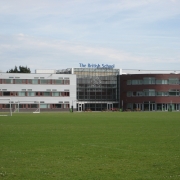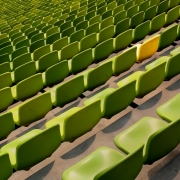Real World Motivation
Rachael Thrash, The International School of Helsinki
Ellen Heyting, The International School of Helsinki and Monash University
Real World Motivation: Harnessing Authentic Audience to Transform Assessment for All Students.
Today’s K-12 educators are diligently moving away from the traditional lecture and note taking methods of teaching towards constructivist views. In daily lessons, we strive to put the learner at the centre of educational experiences. Yet, when it comes to assessment, we are dragging our feet. If we accept the value in these constructivist pedagogies, then surely we must acknowledge that it is time to challenge our traditional notions of assessment as well?
The hallmark of traditional school work is the essay. Its ultimate audience, the teacher, assesses the level understanding a student demonstrates. This approach puts students and teaches in a transactional relationship. And, not surprisingly, students who feel prepared to perform in this way may find this process satisfying. Their efforts yield positive recognition from the authority.
But what about the other learners? How does this model strike them? And even for those ready to show their learning in this format, how does it encourage personalization, risk taking, and empowerment? By limiting the students’ audience to their teachers, we establish a primarily hierarchical relationship between teachers and students. Worse, we miss the opportunity to encourage all of our students to find their voices.
The Inspiration of an Authentic Audience
In contrast to a student who has just completed an essay, picture Ayla, a 10th grader who faces attention and language based learning challenges. Recently, Ayla acted as a docent at a local restaurant where student shared their work in a resistance art installation, “Question The Narrative: Young Artists Challenge Norms That Promote Injustice.” Ayla’s piece exposed Nestle’s abuse of child laborers, including a call to action for consumers. Watching a visitor view her work, she exclaimed, “I have goosebumps! I can’t believe someone actually cares!”
Yolanda, a highly precocious student also grappled with the challenge of creating a meaningful resistance piece for the installation. She pursued ideas and ultimately decided to expose society’s unhealthy version of success. She symbolically repurposed a photo of Justin Beiber on the cover of Forbes, questioning societal values and role models. Her work was both personal and impactful. She explored her own concerns about success and shared them with an audience. The restaurant staff marveled at the customer discussions her piece sparked.
Assessment Constructed to Support Students Connecting with an Audience
These students and their diverse classmates responded to a complex unit digging into hegemonies and resistance. They worked to expose unjust power structures to an audience beyond the teacher assessing them. Alongside this performance challenge, students developed their abilities by analyzing resistance texts and researching hegemonic structures. Assessment on this work became an important feedback mechanism. Created with intention and student growth in mind, it broke down the process of creating a meaningful resistance piece into manageable steps; students practiced disciplinary skills until they developed confidence.
Traditional Assessment vs. Authentic Assessment
Problems with assessment arise when the work is an exercise with a foregone conclusion. The same students always succeed while the students who don’t know the answer or feel unsure of their abilities lose motivation. If a student’s goal is only to show that they can identify symbolism in a resistance text, knowing that the teacher has a particular definition of symbolism, where is their sense of agency? How can they feel empowered?
It is easy to find the shortcomings of traditional essay-based assessments: Tests are based on ‘unseen’ questions, whereas in authentic assessments, as much as possible is known about the task ahead of time, and students have had a chance to practice, get feedback and prepare. Authentic assessments are iterative by nature, involving students and teachers working together to co-construct new understandings of the world. Traditional assessments simply take a ‘snapshot’ of a students’ performance at one point in time. While traditional assessments ask students to reproduce a correct answer, authentic assessments are open-ended and allow for student agency and voice.
Traditional methods of assessing offer the illusion of learning in our students. But ask students to take what they’ve learned and transfer it to a new situations and they may lack the deeper understanding or flexibility. Gardner (1993) argues that authentic assessment tasks must ask students to solve a real world problem or create a product with someone else’s needs in mind, and has value beyond the classroom walls.
Value of Supporting Authentic Learning Through Audience
When we talk about real world experiences, we are showing young thinkers that their opinions matter. They have value outside their achieved grade. Students seek teacher feedback when they know they will share work with a larger audience. The teacher’s role moves from success arbiter to coach. Mistakes become opportunities for improvement rather than reasons to justify a lower grade. Students trust the teacher to help them find their voice.
Consider this range of opportunities for students to share their work:
- Class magazine
- Interviews with community members
- Teaching the parent community
- Raising awareness for a local organization
- Helping other students
- Displaying work in a public space
Does the Extra Effort Yield Results?
We don’t claim to have all the answers to these complex questions. But we have seen the transformation they can bring about in our students. Our 10th graders are visibly enthusiastic to identify concepts they developed in the resistance unit as they read Harlem Renaissance Poetry. Even better, they willingly share their voice in a poetry slam. They have taken ownership of their learning experiences and find value in the process.
Yes, authentic assessments are not perfect, they are risky and messy, but we’re getting better at them. The more educators and schools that move towards this type of pedagogy and assessment, the more we will all learn how to deal with the ambiguities and execute them better. One could argue using authentic assessments is in fact an authentic assessment of our own teaching. If we are willing to take risks in the real world, we model the perseverance and creativity we hope to inspire in our students.
Suggested Breakout Box
Wiggins’ (1998) characteristics that makes assessment authentic:
The assessment is realistic; it mirrors how this knowledge or skill would be used in the real world.
The assessment requires judgment and innovation; the task is open-ended and has more than one right answer.
The assessment incorporates skills that are required in the discipline being studied.
The assessment is done in contexts as close to the real world as possible
The assessment involves a range of skills and deals with a complex problem that requires some degree of informed judgement or choice from the student.
The assessment is iterative and allows for feedback, practice, and redos
Works Cited
Gardner, H. (1993). Frames of Mind (2nd ed.). New York: Basic Books.
Wiggins, G. (1998). Educative Assessment: Designing Assessments to Inform and Improve Student Performance. San Francisco: Jossey-Bass.
ABOUT THE AUTHORS
Rachael is a teacher and social justice advocate who has worked in schools in Poland, the United States, and Finland. She is passionate about inclusive education and its capacity to empower every student to make positive change.
Ellen is a teacher and educational researcher who has worked in schools in Melbourne, Beijing, Singapore and Helsinki and who believes education can be a force to unite people, nations and cultures for an equitable and sustainable future.
BIBLIOGRAPHY
Gardner, H. (1993). Frames of Mind (2nd ed.). New York:Basic Books.
Wiggins, G. (1998). Educative Assessment: Designing Assessments to Inform and Improve Student Performance. San Francisco: Jossey-Bass.














